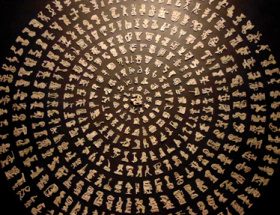From Pictorial Chaos to Poetic Tasting
By Yenny Hernández Valdés
Between lines, colors, fillings, textures… everything appears as intermingled, chaotic, lively. Everything is revealed to us in full poetic, sensorial, retinal, degustable gesture. Everything seems to be overturned in unbridled emotion, in a stroke of visual impact, of pictorial jumble. In this way the Dominican painter, draftsman, cultural manager and writer located in West Palm Beach, Máximo Caminero (Dominican Republic, 1962) “writes” his own creative history of his passage through the curious and intriguing artistic universe, within which his history with painting has been maturing over the years.
Máximo Caminero offers us a symbolic production charged with emotion and poetic texture; he invites us to enter a universe full of lines and mixed colors, of brushstrokes and canvases passionately paired, perhaps untimely as well. The pictorial impulse appreciable in his plastic surfaces and the exquisite grace of delirious brushstrokes, lead me to see in his production a gestural and poetic painting capable of generating emotion, of impacting on the retina from an uninhibited and conscious plastic will.
His sensibility, poured into his plastic action –which is not the only one since Máximo translates his “heartbeats” into writing, as he refers to it– is metaphorized in the existential of the subject, in his passage through this chaotic and sublime world in unison. However, his discourse does not intend to anchor itself –at least for me– in the philosophical-anthropological gloating of the contemporary human being. Caminero starts from his vital experience, from the inherent existential sensibility that, as subjects, we behave, to then translate all of this into a pictorial key with doses of formal experimentation and a manifest interest in the creative process.
Undoubtedly, when we approach Caminero’s work, it can be seen that he is an artist seasoned in technical expertise and in the praxis and mastery of the medium he assumes. This is the consequence of a technical operation that already has years of experience and, therefore, of conceptual maturity as well. In this way, he offers us his “plastic reflections” that detonate like a kaleidoscope effect. Let me explain: a retinal and psychic effect that tends to a disturbing introspection. Letting ourselves be seduced by Caminero’s whirlwind of forms and lines can lead us to a sort of limbo seasoned with this kaleidoscopic effect in which, besides impregnating his processual emotion and his artistic vision, he also offers us the possibility of overturning that sensibility that art awakens in human beings.
Undoubtedly, lyricism is manifest in his works, and he gropes a subjectivity full of emotions, feelings, memories, questionings… His pictorial environments are diagrammed from formal elements –which sometimes become recurrent in his works–, from flat areas of color and also from impastoed areas: all elements that articulate the final composition in a display of sublime expressiveness.
Precisely, this diagramming of “oneiric landscapes”, if you will, which at times appears spontaneous in its visuality, endow the work with a poetic and degustable halo. And I refer to “landscapes” in the work of Máximo Caminero in the metaphorical sense of his creativity of “strange spaces”, plastic environments that are detached from any classificatory ties in aesthetic terms. And certainly, Caminero’s artistic work becomes disturbing inasmuch as we cannot –or we should not, in order not to be naïve–, frame it in one or another aesthetic, style or language.
If we stop to think about the “abstract” as such, we must do so by understanding it from a transversal analysis that goes beyond the hackneyed thoughts that incur in non-figurative art, to access then to a symbolic and epistemological reflection that starts from an interpretation of reality that is not revealed per se, but sifted by a formal imaginary that dwells in the non-common, in the symbolic of a broad and diverse language.
Therefore, the work of Máximo Caminero does not become totally abstract, as figurative elements are sometimes, and in a very intelligent way, available to us in all their explicit visuality. In the trajectory of this artist we come across a vast and varied production in plastic results: from works with a certain minimalist air that transport me to the canvases of Joan Miró, to others a little more variegated of cubist forms like up to date Picassian and displaying a Caribbean horror vacui, to quasi volumetric works by the impasto and the expressionist solution with certain aesthetic airs, perhaps drinking from the poetics of Lam. They are all works that oscillate between the experimental and the emotive, that do not require classifications or stylistic determinisms, that reveal states of their creator and that result in an oxygenating achievement for the observer.
This pictorial diversity leads us to a state of enjoyment that debates between the calm and the impetuous, between the indefinable and the precise: a state that finds its genesis in the artist itself that generates his work. At the end of the day, the work of Máximo Caminero gives off a will of enjoyment for that dynamic in continuum of the plastic action more than for the final result of the work itself. In the background of these delirious brushstrokes, one can see his spontaneity and gestural impulse: degustable and admirable.






